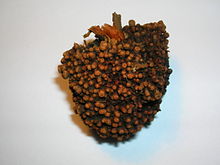| Frankia | |
|---|---|

| |
| An alder root nodule. | |
| Scientific classification | |
| Domain: | Bacteria |
| Phylum: | Actinomycetota |
| Class: | Actinomycetia |
| Order: | Frankiales |
| Family: | Frankiaceae Becking 1970 (Approved Lists 1980)[2] |
| Genus: | Frankia Brunchorst 1886[1] |
| Type species | |
| Frankia alni (Woronin 1866) Von Tubeuf 1895 non Steud. 1840
| |
| Species[3] | |
|
See text | |
| Synonyms | |
Frankia is a genus of nitrogen-fixing bacteria that live in symbiosis with actinorhizal plants, similar to the Rhizobium bacteria found in the root nodules of legumes in the family Fabaceae. Frankia also initiate the forming of root nodules.
This genus was originally named by Jørgen Brunchorst, in 1886 to honor the German biologist Albert Bernhard Frank.[4] Brunchorst considered the organism he had identified to be a filamentous fungus. Becking redefined the genus in 1970 as containing prokaryotic actinomycetes and created the family Frankiaceae within the Actinomycetales. He retained the original name of Frankia for the genus.[5]

- ^ Brunchorst J. (1886). "Über einige Wurzelanschwellungen, besonders diejenigen von Alnus und den Elaegnaceen" [On root swellings, particularly those of Alnus and the Elaeagnaceae]. Untersuchungen aus dem botanischen Institut in Tübingen [Investigations of the Botanical Institute in Tübingen ]. 2 (151–177).
- ^ Becking JH. (1970). "Frankiaceae fam. nov. (Actinomycetales) with one new combination and six new species of the genus Frankia Brunchorst 1886, 174". International Journal of Systematic Bacteriology. 20: 201–220. doi:10.1099/00207713-20-2-201.
- ^ Cite error: The named reference
LPSNwas invoked but never defined (see the help page). - ^ Pawlowski, Katharina (2009-06-17). Prokaryotic Symbionts in Plants. Springer Science & Business Media. p. 107. ISBN 9783540754602.
- ^ "Frankia taxonomy". Archived from the original on 2011-07-27. Retrieved 2011-01-14.